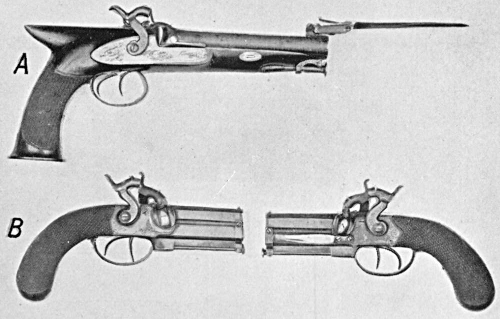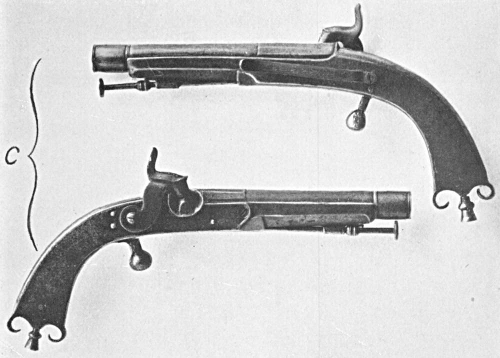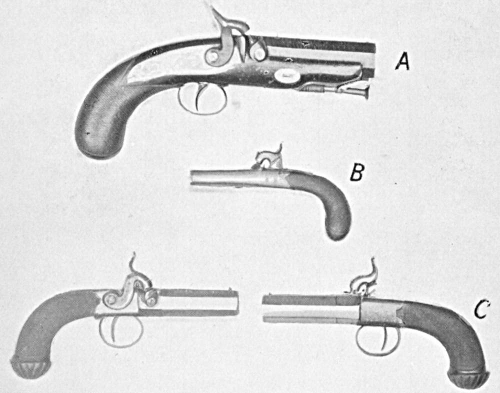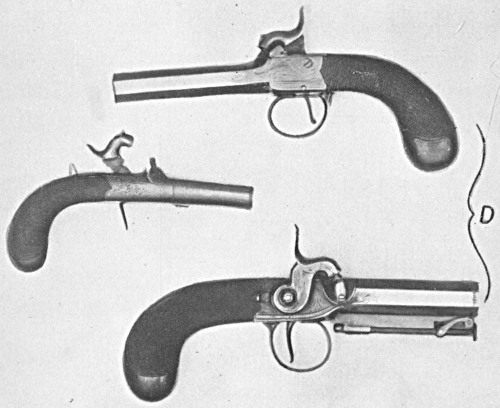The following information on caplock pistols comes from The Book of the Pistol and Revolver by Hugh B. C. Pollard. The Book of the Pistol and Revolver is also available to purchase in print.
The revolution effected by the discovery of the caplock system was not an instantaneous development following the invention, but one which took quite forty years to become universally popular.
In 1807 the Reverend Alexander Forsyth, a Scotch clergyman of Bethvie, patented a system for utilizing fulminating salts to fire powder, and further specified as one of the chief advantages of his system that it prevented any escape of gas through the touch-hole. Forsyth’s invention was not the usual copper cap of later date, or any metallic primer, but consisted of a device attached to the top of the pistol by which a few grains of fulminating powder fell by gravity into a cavity beneath a plunger and over the touch-hole. This plunger, struck by a peg in the nose of the hammer, ignited the charge.

This invention was marketed in 1812, but involving as it did the use of loose priming powder of an easily detonated variety, was neither safe nor popular.
The principle of ignition by percussion attracted universal attention, and gunsmiths in all parts of the world turned their attention to the matter. The result was a series of devices—detonating pellets, tubes, pastilles, and paper caps, as used in toy pistols to-day, or in connected tapes or strings for special primers. All were tried and abandoned in favour of the copper percussion cap, which many makers claim to have invented. Colonel Hawker claims it for Joseph Manton; Mr. Walker, of Philadelphia, has a good right to it! Egg also claimed it, as did many other makers of renown, but by 1815 the copper cap was in limited use on high-class private arms, and by 1830 it had ousted all other systems; and was recognized by both the gun trade and sportsmen as the best and only system of ignition for modern use.

Both flint and caplock weapons were in use at the Battle of Waterloo, but the newly invented percussion pieces were the private property of the officers who carried them. The rank and file still retained the flint-locks, and the very same weapons as were used at Waterloo were used in the Crimean Campaign, forty years later.
It is said that a young officer, William Spain, at that time attached to the Staff, had the ill-fortune to incur the Duke of Wellington’s censure for not carrying a pair of pistols that would take the service ammunition. The pair he was carrying were his caplock duelling pieces made by Fiske of the Strand, and with the dates and occasions of his having been “out” engraved on the silver plates on the butts.

Contemporarily with the caplock system, breech-loading devices came into notice, but owing to escape of gas at the breech none of these were satisfactory till the cartridge had been invented. Numerous experimental weapons are, however, in existence, and pieces of this kind are of value to collectors.
The caplock in its simplest form substitutes for the cumbrous flint-holding hammer and external flash-pan a simple steel nipple communicating with the powder chamber. Upon this nipple is placed a copper capsule or cap, containing a minute charge of fulminate of mercury, or other chemical compound, which detonates or explodes when hit. This cap charge is covered by a disc of tin foil and a drop of varnish, thus rendering the cap more or less waterproof. The fall of the hammer upon the cap crushes the detonating powder between the hammer and the nipple, causing it to explode and fire the charge. The cap held by the hammer over the vent-hole of the nipple prevents any escape of gas, as was inevitable with the open touch-hole of the flintlock, and a better and speedier explosion, with no waste energy, results. In wet weather it was impossible to use a flint-lock, as the priming got damp, and in windy weather misfires were frequent, owing to the blowing away of the priming powder. The copper cap did away with all these disabilities, and increased the certainty of ignition, and decreased the risk of misfires to an incalculable extent.

The new system was universally approved, and by the simple process of fitting a new hammer and removing the flash-pan and cover to substitute a small butt-ended tube screwed at right angles into the enlarged touch-hole of the old barrel, and mounting a nipple upon the tube, flint-locks could be converted to caplock. Converted locks are easily recognized, even if complete new barrels have been fitted, because the hammer has a much longer fall than is usual with the lock built for percussion ignition.
It is seldom possible to reconvert such altered weapons, and never advisable, as modern restorations are never as good as the original work, besides spoiling the genuineness of the piece.
The application of the new system did not modify the established style of pistols, but as rifling—an invention dating from 1498—came into fashion with the development of the caplock system, the new weapons were more often rifled than not. All types of pistols adopted the new lock—horse pistols, duelling pistols, and pocket weapons—and the best of all were fitted with rifled barrels and hair-triggers, adjustable backsights, and all possible mechanical refinements.
The hair-trigger mechanism is typical of this period of duelling weapons, though in later days its use was forbidden. The principle of the hair-trigger is practically that of making the trigger itself into a separate lock, with a very strong spring action on a flying arm of the trigger, which actuates the scear of the pistol lock. The hair-trigger was invented at Munich in 1543, and had long been applied to Continental rifles. Pistols with this action can be recognized by their having a small capstan-headed screw just in front of the trigger, and within the trigger-guard. This screw is the fine adjustment of the hair-trigger action.
The lock is so designed that it can be used or the pistol can be fired by ordinary trigger pull, according to the desire of the shot.
The action is set by pressing the trigger forward. This compresses the spring. A very light touch on the trigger releases its scear from engagement, and in place of the steady pressure from the human finger, it is driven back by the spring against the pistol lock release, the tail of the scear, and fires the pistol with a quicker and clearer action than is possible with the finger pull.
At this time, too, the saw-handle duelling pistol came into favour, but this type of handle, in which the shape was exactly like a tenon saw, was not popular for other uses. I have seen a small pair of all-metal saw-handle pieces with belt hangers and stirrup ramrods by Manton—not Joe Manton, but his successors; but these were probably a special order executed possibly for an officer of the East India Company, as the style was similar to weapons popular in the Indies.
The caplock system rendered pocket arms much less cumbrous and much cheaper to manufacture. Soon a quantity of caplock pocket pairs were on the market, varying from neat little folding trigger weapons, about four inches long, to eight-inch pieces of large bore. None of these had extensions of wood up the barrel, and they were nearly all reversions to the box-lock model, with top hammer (or in better classes “side hammers”); that had always been popular.
The earlier caplock duelling pieces were like the best flint-locks, and had wood up to the muzzle; but soon the better class makers cut down the fore-end to half-way up the barrel, where it had a horn tip; and some altered the style of the locks.
Till 1825 most locks were “side action”—that is to say, they had the main-spring in front of the hammer, and underneath the nipple. These gave place later to “back action” locks, which had the spring behind the hammer along the stock. By 1840 these were the most popular, as they did not weaken the woodwork of the pistol as much as the old system.
The very earliest caplock pieces had the lock secured to the stock by two long screws traversing the stock, exactly as was the practice with flintlocks. In very late flint-locks and most caplocks, one screw (called the “side nail”) alone suffices to hold the lock, while its forward end hooks in under an internal screw head recessed into the wood.
Nearly all first-class duelling pistol locks have a detent and a safety catch integral with the lock mechanism.
There were many and various patents applied to the caplock period. One of the best known of these was Nock’s patent breech, in which a separate chamber was formed between nipple or touch-hole and powder-chamber. Here a few grains of powder found their way, and the flash of the cap had room to expand, insuring a better ignition. Nock’s best pistols—and there was no better make at the time—have these curious and rather heavy breeches, and they are sometimes mistaken for conversions. Nock’s patent breech was, in many ways, a reversion to the old cannon-barrel type, where a separate chamber for the powder was provided. The main point insured by this chamber was that the ball when rammed down did not compress the charge into a solid block that would delay the action of the flash. The same principle was used in mortars.
At this time queer pocket weapons and repeating and multi-shot devices of all kinds attracted the attention of inventors.
The large-bore small-sized pocket pistol known as the “Derringer” was first a muzzle-loading caplock pistol, and another type was the “Delvigne,” with concealed hammer and stud-trigger. This latter piece was breech loading, but smooth bore, and similar to the modern automatic in appearance.
Pistols with safety devices for holding the cap on the nipple, weapons with concealed hammers, under and over barrels, and all sorts of queer oddments, made their appearance, but design had in the main settled down upon sound lines.
With the caplock duelling pistol the development of this type of weapon ceased, for the modern duelling pistol is to-day identical in all respects with those of sixty years ago.
The standard “Gastin-Renette” or “Bastien-Lepage” duelling pistols used in France to-day are smooth-bored muzzle-loading caplock weapons, and it is well to bear in mind that breech-loading or rifled pistols are not allowed to be used under the Duelling Code.
German pistols in pairs, with a bastard Remington action, are sometimes sold or advertised as “duelling pistols”; as, too, are often pairs of large-bore rifled or smooth caplocks, which are properly horse pistols or house defence weapons. The collector should distinguish carefully between these and true duelling pieces.
The rifled duelling pistol has been barred as such for many years; the round-bulleted smooth-bore being judged amply dangerous enough for the purpose of an affair of honour.
The mode of loading rifled caplock pistols was of necessity cumbrous; for after the powder charge had been rammed down, the bullet—spherical or conical—was enclosed in a circular greased linen patch and hammered down upon the powder against the resistance of the rifling by means of a ramrod and mallet. In modern duelling pistols sets in cases a mallet is supplied for this purpose; other fitments include screws for withdrawing the charge, powder-flask, bullet-mould, ramrod, nipple key and a pricker for cleaning blocked nipples. The best sets of the period have sometimes as many as three sets of barrels: one pair smooth bore of duelling length; one a long rifled pair for target work; and the third pair short for carrying in a carriage or upon the person.
The accuracy of good caplock pistols equals that of a rifle, and wonderful practice can be made with them.
The principal development of the caplock system as applied to pistols was the perfection of the revolver—a matter dealt with in the following chapter. At this point, muzzle-loading and breech-loading developments overlap; and as the connection is fully covered by the subject of “Revolvers,” it will be better to take these first, and single-shot, breech-loading pistols later on, despite the fact that muzzle-loading revolvers belong of rights to the chapter on “The Percussion System.”
